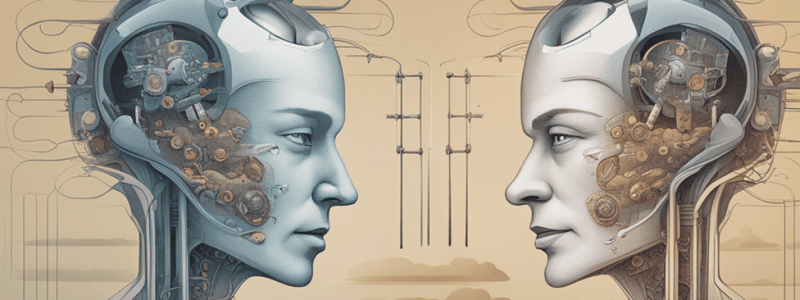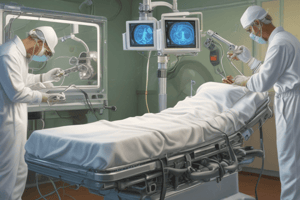Podcast
Questions and Answers
How has robotic surgery contributed to better patient outcomes?
How has robotic surgery contributed to better patient outcomes?
- By leading to fewer complications and better outcomes (correct)
- By reducing precision and control
- By increasing complications during operations
- By prolonging hospital stays
How does robotic surgery contribute to potential structural unemployment?
How does robotic surgery contribute to potential structural unemployment?
- By creating more job opportunities
- By increasing demand for human labor in healthcare
- By reducing the need for certain traditional roles (correct)
- By not affecting employment in any way
In the context of economic concepts, what does creative destruction refer to?
In the context of economic concepts, what does creative destruction refer to?
- Creating new job opportunities in healthcare
- Improving patient outcomes through technology
- Replacing older methods with newer, more efficient ones (correct)
- Increasing the costs of healthcare procedures
What is one of the potential drawbacks of robotic surgery mentioned in the text?
What is one of the potential drawbacks of robotic surgery mentioned in the text?
In the context of technological advancement, what does structural unemployment primarily result from?
In the context of technological advancement, what does structural unemployment primarily result from?
What are the positive externalities of robotic surgery (2 answers)
What are the positive externalities of robotic surgery (2 answers)
Flashcards are hidden until you start studying
Study Notes
Robotic Surgery: Positive Externalities, Negative Externalities, Creative Destruction, Structural Unemployment, and Benefits
Robotic surgery has emerged as a promising field with significant implications for healthcare systems worldwide. This technology brings both opportunities and challenges, which can be analyzed through various economic concepts such as positive externalities, negative externalities, creative destruction, and structural unemployment. In this article, we will explore these aspects of robotics, followed by a discussion on the potential benefits of implementing robotic surgery.
Positive Externalities
Positive externalities refer to situations where one party's actions benefit others who did not directly participate in those actions. In the context of robotic surgery, there are several positive externalities that can arise from its widespread adoption:
-
Better Patient Outcomes: Advances in robotic surgical techniques have led to improved precision and control during operations, resulting in fewer complications and better patient outcomes.
-
Reduced Hospital Stay: Since surgeries performed using robots often require less invasive procedures, patients undergoing robotic surgery may experience shorter hospital stays compared to traditional open surgeries.
-
Lower Healthcare Costs: With quicker recovery times and reduced risk of infection, healthcare costs associated with postoperative care are potentially diminished when utilizing robotic surgery.
These positive externalities contribute to overall improvements in healthcare delivery and patient wellbeing.
Negative Externalities
Negative externalities occur when certain activities generate undesirable consequences for parties other than the direct participants in the activity. Although robotic surgery presents many advantages over conventional methods, it also introduces some potential drawbacks:
-
Initial Investment Costs: Hospitals and medical facilities investing in robotic surgery equipment face substantial upfront expenses. However, these investments could pay off in terms of cost savings down the line due to enhanced efficiency and effectiveness.
-
Learning Curve: While experts agree that surgeons need time to master new technologies like robotic surgery tools, there is still room for debate concerning how much training is necessary before they can perform effectively. Until surgeons gain more proficiency with robotic devices, hospitals might encounter slower growth rates until all doctors become sufficiently skilled.
Despite these negative externalities, the overall impact of robotic surgery on society appears favorable based on analysis thus far.
Creative Destruction
The concept of 'creative destruction' was first introduced by Joseph Schumpeter as part of his theory of innovation and development within economies. It refers to the process where old industries decline while new ones emerge, leading to job displacement among workers whose skills were relevant only in the previous industry.
As robotic surgery continues to advance rapidly, there could certainly be cases where jobs requiring manual dexterity may become obsolete or significantly altered due to automation. For instance, some positions related to patient preparation tasks—such as positioning patients correctly prior to surgery—could eventually be automated entirely or partly if adaptors or sensors are developed that allow robots to take over these roles. However, this does not necessarily imply loss of employment; instead, it suggests transformation and reallocation of labor resources into newer sectors supported by emerging technologies.
Structural Unemployment
Structural unemployment describes a form of unemployment caused by mismatches between available jobs and workers’ skills, lack of information regarding job vacancies, and geographical immobility. As technological progress accelerates, societies must adapt their education systems accordingly so individuals can acquire the right skill sets needed for future careers.
In regards to robotic surgery specifically, potential areas experiencing structural unemployment would likely involve professionals who previously relied heavily on highly specialized hands-on skills now being replaced by robotic counterparts —an example being diagnostic radiologist assistants or technicians losing work due to increased automation within imaging fields. Therefore, it becomes crucial for institutions and governments alike to adjust curricula and invest in retraining programs tailored towards preparing existing workforces and newly unemployed persons for new occupational niches arising out of innovations like robotic technology.
Benefits of Implementing Robotic Surgery
Beyond the above analyses, here are additional points highlighting why advancing towards more extensive usage of robotic surgery could prove highly beneficial:
-
Improved Accuracy and Precision: Robotic arms offer unparalleled levels of accuracy during complex surgeries because they don't tire like human muscles do. Thus, operations executed via remote-controlled machines lead to higher success rates in comparison to traditional means.
-
Wider Accessibility: Given its ability to reach even hard-to-access parts within human bodies without necessitating large incisions, minimally invasive robotic interventions hold great promise especially for treating rare diseases or conditions affecting specific regions deep inside our organs.
-
Decreased Pain Sensitivity: A study published in JAMA Surgery found that patients report lower pain sensitivity after robotic prostatectomy versus open radical retropubic prostatectomy. Lessened discomfort translates into speedier recoveries and reduced dependence on narcotics post-surgery.
In conclusion, understanding robotic surgery within the framework of economics helps us appreciate its inherent complexity - balancing gains against losses is key to maximizing societal welfare. We see evidence suggesting positive impacts across numerous fronts: enhancing patient health outcomes; streamlining resource utilization among providers; and fostering further scientific advances due to tightening feedback loops present within machinery design processes. Yet, challenges remain such as ensuring equitable distribution of benefits amongst stakeholders including individual citizens, employers, educators, policy makers etc... One thing seems certain though-the pace at which technology evolves calls upon us all to continuously adapt and respond promptly lest we fall behind!
Studying That Suits You
Use AI to generate personalized quizzes and flashcards to suit your learning preferences.




